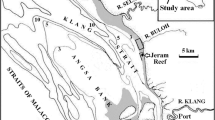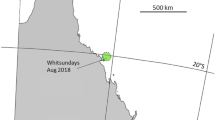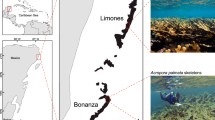Abstract
Coral reef lagoons are generally regarded as zones of net heterotrophy reliant on organic detritus generated in more productive parts of the reef system, such as the seaward reef flat. The abundance and biomass of sediment infauna were measured seasonally for one year (1986) within the lagoon of Davies Reef, central Great Barrier Reef, to test the hypothesis that macrofaunal biomass and production of coral reef lagoons would decrease with distance from the reef flat and would change seasonally. In general, there were no simple relationships between infaunal standing stock or production and distance from the reef flat or season. Bioturbation by callianassid shrimps negatively affected the abundance of smaller infauna, suggesting a community limited by biogenic disturbance rather than by supply of organic material. Polychaetes and crustaceans were dominant amongst the smaller infauna (0.5 to 2mm) while larger animals (> 2 mm) were mostly polychaetes and molluscs. Mean biomass of infauna at both sites and all seasons was 3 181 mg C m−2. The smaller animals (0.5 to 2 mm) contributed about 40% of total macrofaunal respiration and production although they represented only 15% of the total macrofaunal biomass. The biomass of macrofauna was about equal to that of the bacteria and meiofauna, while respiration represented 10 to 20% of total community respiration. Consumption by macrofauna accounts for only 3 to 11% of total organic inputs to sediment, with a further 14 to 17% being lost by macrofaunal respiration.
Similar content being viewed by others
Literature cited
Aller, R. C., Dodge, R. E. (1974). Animal-sediment relations in a tropical lagoon, Discovery Bay, Jamaica. J. mar. Res. 32: 209–232
Alongi, D. M. (1988). Detritus in coral reef ecosystems: fluxes and fates. Proc. 6th. int. Symp. coral Reefs 2: 29–36 [Choat, J. H. et al. (eds.) sixth International Coral Reef Symposium Executive Committee, Townsville, Australia]
Alongi, D. M. (1989). The role of soft-bottom benthic communities in tropical mangrove and coral reef ecosystems CRC critical Rev. aquat. Sciences 1: 243–280
Ansell, A. D., McLusky, D. S., Stirling, A., Trevallion, A. (1978). Production and energy flow in the macrobenthos of two sandy beaches in South West India. Proc. R. Soc. Edinb. 76: 269–296
Banse, K. (1982). Mass-scaled rates of respiration and intrinsic growth in very small invertebrates. Mar. Ecol. Prog. Ser. 9: 281–297
Banse, K., Mosher, S. (1980). Adult body mass and annual production/biomass relationships of field populations. Ecol. Monogr. 50: 355–379
Barnes, D. J. (1988). Seasonality in community productivity and calcification at Davies Reef, central Great Barrier Reef. Proc. 6th int. Symp. coral Reefs 2: 521–527 [Choat, J. H. et al. (eds.) Sixth International Coral Reef Symposium Executive Committee, Townsville, Australia]
Blum, J. J. (1977). On the geometry of four dimensions and the relationship between metabolism and body mass. J. theor. Biol. 64: 599–601
Crisp, D. J. (1971). Secondary productivity in the sea. In: Richle, O. E., Franklin, J. F., Goodall, O. W. (eds.) Productivity of world ecosystems. National Academy of Sciences, p. 71–89
Fauchald, K., Jumars, P. A. (1979). The diet of worms: a study of polychaete feeding guilds. Oceanogr. mar. Biol. A. Rev. 17: 193–284
Furnas, M. J., Mitchell, A. W. (1988). Phytoplankton primary production measurements in reef lagoons. Data Rep. Aust. Inst. mar. Sci. (Townsville, Qld)
Hammond, L. S. (1982). Patterns of feeding and activity in depositfeeding holothurians and echinoids (Echinodermata) from a shallow back-reef lagoon, Discovery Bay, Jamaica. Bull. mar. Sci. 32: 549–571
Hansen, J. A., Alongi, D. M., Moriarty, D. J. W., Pollard, P. C. (1987). The dynamics of benthic microbial communities at Davies Reef, central Great Barrier Reef. Coral Reefs 6: 63–70
Harriot, V. J. (1984). Census techniques, distribution, abundance and processing of large sea-cucumber species (Echinodermata: Holothuroidea) on the Great Barrier Reef. Report to the Great Barrier Reef Marine Park Authority, June 1984 (internal publication)
Hatcher, B. G. (1983). The role of detritus in the metabolism and secondary production of coral reef ecosystems. In: Baker, J. T. et al. (eds.) Proceedings of the Inaugural Great Barrier Reef Conference, Townsville, Aug. 28–Sept. 2 1983. JCU Press, Townsville, p. 317–324
Ivleva, I. V. (1980). The dependence of crustacean respiration rate on body mass and habitat temperature. Int. Revue ges. Hydrobiol 65: 1–47
Kinsey, D. W. (1985a). Metabolism, calcification and carbon production. I. Systems level studies. Proc. 5th. int. Symp. coral Reefs 4: 505–526. [Gabrié, C. et al. (eds.) Antenne Museum-EPHE, Moorea, French Polynesia]
Kinsey, D. W. (1985b). The functional role of back-reef and lagoonal systems in the central Great Barrier Reef. Proc. 5th. int. Symp. coral Reefs 6: 223–228. [Gabrié, C. et al. (eds.) Antenne Museum-EPHE, Moorea French Polynesia]
Klumpp, D. W., McKinnon, A. D. (in press). Temporal and spatial patterns in primary production of a coral reef epilithic algal community. J. exp. mar. Biol. Ecol.
Lewis, J. B. (1980). Coral reef ecosystems. In: Longhurst, A. R. (ed). Analysis of marine ecosystems. Academic Press, London, p. 127–158
Longhurst, A. R., Pauly, D. (1987). Ecology of tropical oceans. Academic Press, San Diego
MacIntosh, D. J. (1984). Ecology and productivity of Malaysian mangrove crab populations (Decapoda: Brachyura). In: Soepadmo, E., Rao, A. N., MacIntosh, D. J. (eds.). Proceedings of the Asian symposium on mangrove environments: research and management, 25–29 August 1980. University of Malaysia Press Kuala Lumpur p. 354–377
Maslin, J.-L., Pattee, E. (1989). The production ofCorbula trigona (Bivalvia) in relation to its demographic strategies in a West African lagoon. Oikos 55: 194–204
McMahon, T. (1973). Size and shape in biology. Science, N.Y. 179: 1201–1204
McNeill, S., Lawton, J. H. (1970). Annual production and respiration in animal populations. Nature, Lond. 225: 472–474
Miller, R. J. Mann, K. H., Scarratt, D. J. (1971). Production potential of a seaweed-lobster community in Eastern Canada. J. Fish. Res. Bd. Can. 28: 1733–1738
Odum, E. P., Odum, H. T. (1955). Trophic structure and productivity of a windward coral reef community on Eniwetok Atoll. Ecol. Monogr. 25: 291–320
Parulekar, A. H. (1984). Studies on the growth and age of bivalves from temperate and tropical estuarine ecosystems. Indian J. mar. Sci. 13: 193–195
Pickard, G. L. (1986). Effects of wind tide on upper-layer currents at Davies Reef, Great Barrier Reef, during MECOR (July–August 1984). Aust. J. mar. Freshwat. Res. 37: 545–565
Platt, T., Silvert, W. (1981). Ecology, physiology, allometry and dimensionality. J. theor. Biol. 93: 855–860
Tudhope, A. W. (1983). Processes of lagoonal sedimentation and patch reef development, Davies Reef, Great Barrier Reef of Australia. Ph.D. thesis, University of Edinburgh
Underwood, A. J. (1981). Techniques of analysis of variance in experimental marine biology and ecology. Oceanogr. mar. Biol. A. Rev. 19: 513–605
Vaugelas, J. V., de (1981). Organic matter composition in lagoon sediments of French Polynesia. Proc. 4th. int. Symp. coral Reefs 1: 411–416. [Gomez, E. D. et al. (eds.) Marine Sciences Center, University of the Philippines]
Vaugelas, J. V. de, Naim, O. (1981). Organic matter distribution in the marine sediments of the Jordanian Gulf of Aqaba. Proc. 4th. int. Symp. coral Reefs 1: 405–410. [Gomez, E. D. et al. (eds.) Marine Sciences Center, University of the Philippines]
Villiers, L., Christien, D., Severe, A. (1987). Investigations sur l'ecologie des sables lagonaires biogenes de l'atoll de Mururoa. (Tuamotu Polynesie Francaise). ORSTOM Tahiti, Notes Docums océanogr. ORSTOM 36: 1–98
Waters, T. F. (1977). Secondary production in inland waters. Adv. ecol. Res. 10: 91–164
Wilkinson, C. R. (1987). Microbial ecology on a coral reef. Search, Sydney 18: 31–33
Winer, B. J. (1971). Statistical principles in experimental design. 2nd. ed. MacGraw-Hill, Kogakusha, Tokyo
Author information
Authors and Affiliations
Additional information
Communicated by G. F. Humphrey, Sydney
Contribution No. 488 from the Australian Institute of Marine Science
Rights and permissions
About this article
Cite this article
Riddle, M.J., Alongi, D.M., Dayton, P.K. et al. Detrital pathways in a coral reef lagoon. Mar. Biol. 104, 109–118 (1990). https://doi.org/10.1007/BF01313164
Accepted:
Issue Date:
DOI: https://doi.org/10.1007/BF01313164




